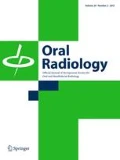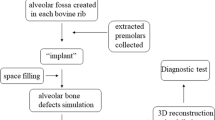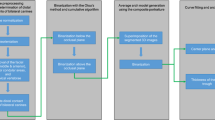Abstract
Objectives
The purpose of this study was to clarify the difference in diagnostic accuracy for alveolar bone defects of the mandibular molar region between cone-beam computed tomography (CBCT) and multidetector-row CT (MDCT) by receiver-operating characteristic (ROC) analysis.
Methods
Artificial alveolar bone defects in a dry human mandible were scanned with a CBCT system (CB MercuRay; Hitachi Medical Corporation) and an MDCT scanner (Aquilion 16-slice; Toshiba Medical Systems Corporation). The field of view (FOV) for the CT images was 5, 10, and 15 cm. Five radiologists observed the obtained DICOM CT images using OsiriX version 3.8.1 (OsiriX Foundation) on an iMac computer (Apple Computer Inc.), and rated the confidence levels for detecting the bone defects using a continuously distributed test. The areas under the ROC curves (Az values) were then calculated with ROCKIT 1.1B (Charles E Metz, The University of Chicago). The significance of differences in the Az values between CBCT and MDCT was tested by the Steel–Dwass method with a significance level of 5 %.
Results
The overall differences in the Az values between CBCT and MDCT were not significant. However, in the images with 15-cm FOV, the Az value for CBCT was significantly lower than that for MDCT.
Conclusions
The diagnostic accuracy for alveolar bone defects was comprehensively equal between CBCT and MDCT. In CBCT, a large FOV can be avoided to reduce the radiation exposure dose, because enlargement of the FOV does not improve the diagnostic accuracy.









Similar content being viewed by others
References
Arai Y, Tammisalo E, Iwai K, Hashimoto K, Shinoda K. Development of a compact computed tomographic apparatus for dental use. Dentomaxillofac Radiol. 1999;28:245–8.
Gulsahi A, Ates U, Tirali RE, Cehreli SB. Use of cone-beam computed tomography in diagnosis of an otherwise undetected periapical lesion in an anomalous tooth. Oral Radiol. 2014;30:111–4. doi:10.1007/s11282-013-0130-8.
Scarfe WC, Farman AG, Sukovic P. Clinical applications of cone-beam computed tomography in dental practice. J Can Dent Assoc. 2006;72:75–80.
Honda K, Arai Y, Kashima M, Takano Y, Sawada K, Ejima K, et al. Evaluation of the usefulness of the limited cone-beam CT (3DX) in the assessment of the thickness of the roof of the glenoid fossa of the temporomandibular joint. Dentomaxillofac Radiol. 2004;33:391–5. doi:10.1259/dmfr/54316470.
Seeram E. Computed tomography: physical principles, clinical applications, and quality control. 3rd ed. St. Louis: Saunders Elsevier; 2009.
Rosset A, Spadola L. OsiriX: an open-source software for navigating in multidimensional DICOM images. J Digit Imaging. 2004;17:205–16. doi:10.1007/s10278-004-1014-6.
Kalra MK, Maher MM, D’Souza R, Saini S. Multidetector computed tomography technology: current status and emerging developments. J Comput Assist Tomogr. 2004;28:S2–6.
Liang X, Jacobs R, Hassan B, Li L, Pauwels R, Corpas L, et al. A comparative evaluation of cone beam computed tomography (CBCT) and multi-slice CT (MSCT). Part I. on subjective image quality. Eur J Radiol. 2010;75:265–9. doi:10.1016/j.ejrad.2009.03.042.
Liang X, Lambrichts I, Sun Y, Denis K, Hassan B, Li L, et al. A comparative evaluation of cone beam computed tomography (CBCT) and multi-slice CT (MSCT). Part II: on 3D model accuracy. Eur J Radiol. 2010;75:270–4. doi:10.1016/j.ejrad.2009.04.016.
Metz CE. ROC methodology in radiologic imaging. Invest Radiol. 1986;21:720–33.
Rockette HE, Gur D, Metz CE. The use of continuous and discrete confidence judgments in receiver operating characteristic studies of diagnostic imaging techniques. Invest Radiol. 1992;27:169–72.
Imhof H, Czerny C, Dirisamer A. Head and neck imaging with MDCT. Eur J Radiol. 2003;45:S23–31.
Bonel HM, Jäger L, Frei KA, Galiano S, Srivastav SK, Flohr T, et al. Optimization of MDCT of the wrist to achieve diagnostic image quality with minimum radiation exposure. AJR Am J Roentgenol. 2005;185:647–54.
McCollough CH, Primak AN, Braun N, Kofler J, Yu L, Christner J. Strategies for reducing radiation dose in CT. Radiol Clin North Am. 2009;47:27–40.
Hsieh J. Image quality. In: Seweram E, editor. Computed tomography: physical principles, clinical applications, and quality control. 3rd ed. St. Louis: Saunders Elsevier; 2008. p. 188–217.
Wojciechowski W, Urbanik A, Kownacki P, Kownacki S, Sowa A. Optimisation of the CT parameters with evaluation of MDCT double-scan images in the planning of the dental implant treatment. Pol J Radiol. 2009;74:69–76.
Fahrig R, Moreau M, Holdsworth DW. Three-dimensional computed tomographic reconstruction using a C-arm mounted XRII: correction of image intensifier distortion. Med Phys. 1997;24:1097–106.
Scarfe WC, Farman AG. Cone-beam computed tomography: volume acquisition. In: White SC, Pharoah MJ, editors. Oral radiology: principles and interpretation. 3rd ed. St. Louis: Elsevier Health Sciences; 2013. p. 185–98.
Seweram E. Multislice spiral/helical computed tomography: physical principles and instrumentation. In: Seweram E, editor. Computed tomography: physical principles, clinical applications, and quality control. 3rd ed. St. Louis: Saunders Elsevier; 2008. p. 226–304.
Baba R, Konno Y, Ueda K, Ikeda S. Comparison of flat-panel detector and image-intensifier detector for cone-beam CT. Comput Med Imaging Graph. 2002;26:153–8.
Baba R, Ueda K, Okabe M. Using a flat-panel detector in high resolution cone beam CT for dental imaging. Dentomaxillofac Radiol. 2004;33:285–90.
Conflict of interest
The authors declare that they have no conflict of interest.
Ethical Standards
This article does not contain any studies with human or animal subjects performed by any of the authors.
Author information
Authors and Affiliations
Corresponding author
Rights and permissions
About this article
Cite this article
Minami, S., Ohnishi, T., Sano, T. et al. Comparison between cone-beam CT and multidetector-row CT by ROC analysis regarding diagnostic accuracy for artificial alveolar bone defects in the mandibular molar region. Oral Radiol 31, 97–104 (2015). https://doi.org/10.1007/s11282-014-0189-x
Received:
Accepted:
Published:
Issue Date:
DOI: https://doi.org/10.1007/s11282-014-0189-x




